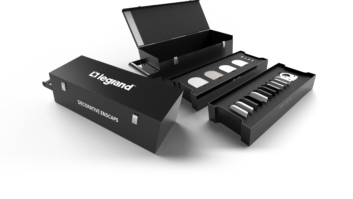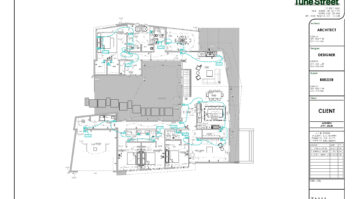In a perfect world, Sam Cavitt would wake up early, grab a surfboard, and ride the waves along the pristine shorelines of Hawaii before reporting to work as a home theater designer on the

This Tuscany-themed home theater project in Palm Desert, California, features high-end aesthetics, top-of-the-line audio and video technology, and pinpoint-accurate acoustical performance, thanks to innovation design solutions from Paradise Theater’s Sam Cavitt and a team for integrators and consultants. island of Maui. In that same perfect world, the owner of Paradise Theater also would be summoned by a client, architect, or builder only during the very early stages of a theater project, not after a home’s foundation, framing, and HVAC system already had been designed. For Cavitt, two out of three definitely isn’t bad.
Cavitt moved from Southern California to Hawaii in 2003 with the to pursue one of his passions—surfing—while maintaining the other— home theater design—as

a career. Modern technology has enabled him to do both successfully, as evidenced by a recently completed Tuscanythemed home theater project in a Palm Desert, California, country club community that features high-end aesthetics, top-of-the-line audio and video technology, and pinpoint-accurate acoustical performance.
While his contributions on the Schlender Theater project ultimately resulted in a room that looks great and sounds amazing, Cavitt would have preferred a different path to that success. If he had it his way, even a modest media room project would involve a theater designer to consult with the project’s integrator, architect, builder, and interior designer. Cavitt has found that even integrators often wait too long to call on the services that Paradise Theater provides.
The ability to produce a room that delivers a true home theater experience requires a lot of planning and integration. Often, a company like Paradise Theater is asked to take and improve an integrator’s design, such as creating a “quiet room” that blocks outside sounds from the theater environment, enabling an audience member to hear the subtle rustling of leaves in a suspense thriller or even the last somber note of a violin solo from a musical program.
It is not a fluke that Cavitt has become a respected professional and in-demand industry educator. Involved in the custom integration industry since 1992, Cavitt also has rounded out his experience with stints in the high-end residential design and construction industry and music and professional audio business. He is a CEDIA Design Level I Certified Designer, a THX Tech I and II professional, and continues to create award-winning system designs and home theater projects, including the CEDIA Best Large Home Theater 2008.
Paradise Theater integrates the performance requirements of acoustics, technical, construction, and aesthetics, providing its services exclusively through systems integrators. “Our business model is to add our core competency and service capabilities to integrators so they can focus on what they do best,” Cavitt explained. “Our mission is to provide the highest level of design and engineering in the home theater specialty. The combination of our business model and mission means the integrator, collaborating with Paradise Theater, will act as an equal member of the design team working with the architect, designer, and builder to deliver the performance potential to the client’s highest expectations.”
Paradise Theater always works with the integrator to specify the right equipment to work with all of the project characteristics and requirements. If the dealer does not have a product to fit the bill, Cavitt and his team help them acquire and add the appropriate product to their mix. They also provide all of the necessary engineering to integrate the systems into the room design, including projection and screen placement, housing, ventilation, speaker placement, housing, mounting, etc; equipment rack placement, room, and isolation.
THE SCHLENDER THEATER
Somewhat to Cavitt’s chagrin, Paradise Theater was introduced to the Schlender Theater project after it was already underway.

The most vexing challenge involved a set of six Debi Schroth-designed Trompe Loeille murals, located under arches on both side walls. The obvious problems with the murals related to their reflective qualities, both visually and aurally. The project’s AV consultant Scott Hudson had initially recommended Cavitt and his team as essential to the success of their high-performance dedicated theater. The client, however, initially declined this recommendation because the architect was already providing theater architecture design and an interior designer the aesthetics. But as the project progressed the need for theater design services became more evident as dimensional modifications needed to be made to accommodate the projector’s throw distance, proper seating and speaker positions had to be determined, screen and projector positioning needed to measured, acoustical performance finetuned, and proper integration of technology with the interior design had to be accomplished.
Once they were on board, the Paradise Theater team interviewed the client, using a pre-designed list of considerations. The goal, Cavitt said, was to engage the client in a conversation about his theater and to find out what he really wanted.
“We learned that the client wanted outstanding video and audio performance and a quiet room, yet was less concerned with containing the soundin the room than having an elegant theater design. The theater designs he had been presented with to that point were not what he wanted.”
The next step was to confirm equipment specifications with the integrator, RadioActive. Cavitt was satisfied with the original equipment specs provided by Hudson, the consultant. Working with RadioActive and its project engineer, Ray Bauman, Cavitt examined the equipment list, rack elevation drawings, and product cut sheets. Some equipment was upgraded to include a Stewart Cinecurve screen, anamorphic lens assembly for the Digital Projection-brand projector, and upgraded JBL Synthesis Array speakers. “At that point we generated screen drawing and specifications, speaker cut sheets, and system cut sheets for all equipment to be included in the theater,” Cavitt explained.
MAKING COMPROMISES
For Cavitt and his team, joining a project already in progress also meant adjusting and interrupting the schedule of the builder, Ram Development. Compromises had to be made on both sides to accomplish the client’s goals. For instance, to create an acoustically quiet room, Paradise Theater specified and designed decoupled wall and ceiling construction, including enclosures for the JBL Synthesis speakers and lighting cans. This required the builder to halt his work in the theater while these specialty construction elements were completed. It also meant that the already-installed lighting cans had to be removed and re-installed inside specially designed decoupled housings.
What did not work in the integration team’s favor, though, was their desire for an independent HVAC system. Under normal circumstances this is an absolute requirement for a quiet room theater design, because zoned, shared, and damped systems will always leak sound from one room to another. Due to the cost to remove and provide a new system, however, this goal was not accomplished.
The interior designer’s vision for the aesthetics of the theater also forced the integration team to compromise. “The client had worked with his interior designer closely throughout the residence and the late Jack Knox had done a wonderful job creating a very comfortable Tuscany home which, ironically or not, fit the desert


Cavitt’s team had reproductions of the murals created by the artist and sent them out for perforation. The design team tested several perforation patterns to find the right compromise. Too many holes that were too large degenerated the look of the art, while too few and too small holes compromised the acoustical characteristics. home,” Cavitt said of the project. “The direction of bringing the Tuscany interior into the theater, however, had reached an impasse by the time Paradise Theater was brought on board.”
When they first met, Cavitt and Knox discussed the vision they had for the room. The most vexing challenge involved a set of six Debi Schroth-designed Trompe Loeille murals, located under arches on both side walls. The obvious problems with the murals related to their reflective qualities, both visually and aurally. Their $12,000 price tag and their aesthetic beauty made abandoning them an undesirable option.
FIXING PROBLEMS
To address visual concerns related to the murals, Cavitt and his team specified a 2.35:1 Stewart Cinecurve screen, and repositioned it to focus the light away from the side walls, minimize reflection, and provide a proper viewing angle.
The acoustic solution was more challenging. Cavitt’s team had reproductions of the murals created by the artist and sent them out for perforation. The design team tested several perforation patterns to find the right compromise. Too many holes that were too large degenerated the look of the art, while too few and too small holes compromised the acoustical characteristics. “We found a very acceptable pattern that enabled us to stretch the canvas murals over upholstery track and broadband acoustical devices,” Cavitt said. “The satisfaction of solving issues like this is one of the great benefits of our job.”
INTEGRATING DESIGN ELEMENTS
One last sticking point was the client’s interest to have more elegant woodwork and the interior designer’s resistance to having that much reflective material in the theater. Paradise Theater resolved the issue by taking many of the interior designer’s elements and integrating them with the wood details that the client described.
Essential to achieving these design goals was collaboration with a millwork contractor, Philip Nikolich of Advanced Woodwork. Paradise Theater created a very detailed millwork design with moldings at curved arches, a complicated proscenium, a cove ceiling with millwork detail, and some pilasters. All this had to be integrated with acoustical devices, including upholstered murals from Austin Halliday over broadband acoustical devices, acoustical plaster, and loudspeakers in the pilasters.
DIALING IN THE ROOM
Acoustically the room features an isolation channel design with constrained layer damping on all walls and ceiling. Doors were fitted with automatic door bottoms and positive seal gaskets. All lighting cans were housed in decoupled isolation enclosures. The infinite baffle design in the screen wall optimizes the performance of the LCRs behind the acoustically transparent screen and broadband absorbers were placed in the cavity to deal with any additional unwanted resonance.
The ceiling, including the cove, was treated with an acoustical plaster material, which provides much less high-frequency absorption than typical applications. This provided a room with proper tonal balance and accurate imaging for soundtrack reproduction.
The Schlender Theater features the very first JBL Synthesis Two Array System installed and commissioned in the world. Chris Neumann, director of sales for JBL Synthesis, performed final calibration of the system using the company’s proprietary DACS (Digital Acoustic Calibration System). The HF response had very little variation from their target frequency response, and the room modes were well under control.
“The JBL Synthesis Two Array, now with a stunning amount of head room and clarity, was able to articulate the small ocean ripples, restless men, and flapping sails from the British frigate through to the 122db cannon blasts during the battle scene from Master and Commander on the DTS sampler DVD,” Neumann said.
FINAL RESULT
The payoff for this huge collaborative effort came when the client, Tom Schlender, who had been worried that the theater would not meet his expectations, gave Cavitt a call toward the end of the project. “I was on the road at the time, providing a CEDIA Theater Design Workshop,” Cavitt recalled. “He had called to let me know that he had just walked into his theater, and everyone was putting on the finishing touches. He had been away for some time and had not seen the room’s progress. He wanted to personally thank me for doing such a nice job and far exceeding his expectations. The entire team deserves that credit. This is the best reward we can hope for.”
Jeremy J. Glowacki is editorial director of Residential Systems in Carmel, Indiana.







